University-Campus-Based Zero-Carbon Action Plans for Accelerating the Zero-Carbon City Transition
Abstract
1. Introduction
1.1. Transition from Global to City-Level Climate Action Plans
1.2. The Role of City–Campus Relationship
- To what extent can a university campus and its multidimensional activities hamper and promote urban sustainability?
- How can the carbon emissions of an HEI campus be calculated?
- What are the potential methods to scale up HEI-based zero-carbon practices?
2. The Impact of Higher Education Institutes (HEIs) on Community-Level Climate Action Plans
| Obligations | Declarations/Agreements/Treaty |
|---|---|
| The lack of acknowledgment of HEIs’ operational and functional activities that could impact or accelerate sustainable environment. |
|
| The acknowledgment of “Environmental education” only as a measure of fighting climate change globally. |
|
| The acknowledgment of CO2 emissions generated from activities of HEIs’ research, education, and campus operations. |
|
| Acknowledgment of the need for special assessment and monitoring tools for ensuring campus sustainability. |
|
| An emphasis on “Sustainable campus operation”, a combined effort to achieve campus sustainability. |
|
3. The Ways of Calculating the Carbon Emissions of University Campuses
| University | Country/ Region | Type of Study | Scale | Target/Goal | Research Content | Sources | |
|---|---|---|---|---|---|---|---|
| Emission Sources | Accounting Method | ||||||
| NTNU | Norway | Demonstration | Campus scale |
| Scope 1, 2, and 3 | Environmental Extended Input–Output (EEIO) | [44] |
| NCUWREP | China | Case study | Campus scale |
| Scope 1, 2, and 3; carbon offset | Nexus model | [46] |
| De Montfort University | UK | Case study | Campus scale |
| Scope 1, 2, and 3 | IPCC method | [45] |
| Carleton University | Canada | Demonstration | Building scale |
| Scope 1 and 2 | The proposed method used Sankey layout code to generate Scalable Vector Graphics (SVG) | [51] |
| South Bank University | UK | Pilot project | Building scale |
| Scope 2 | The multiple regression (MR) technique was used for one dependent variable and six explanatory variables | [29] |
| Global study | Global | Systematic literature review (SLR) | Campus scale |
| The identification of scopes for facilitating the inclusion of the SDGs into higher education | [27] | |
| TERI University | India | Demonstration | Campus scale |
| Scope 1, 2, and 3 | CaNSEC | [41] |
| University of Jaime I | Spain | Demonstration | Campus scale |
| Scope 2 and 3 | CO2UNV | [47] |
| University of Pertamina | Indonesia | Demonstration | Campus scale |
| Scope 2 and 3 | IPCC, WARM model | [52] |
| Ohio State University | USA | Demonstration | Campus scale |
| Scope 1 and 2 | Development of Designing Climate Action and Regulations for Sustainability framework (DCARB) based on user input and mixed-integer linear program (MILP) | [43] |
| Universal study | Global | Literature Review | Building scale |
| Systematic literature review using descriptive statistical analysis | [53] | |
| Technical University of Madrid | Spain | Demonstration | Building scale |
| Scope 1, 2, and 3 | A compound method based on financial accounts | [54] |
| Regional Study | USA | Case study | Campus scale |
| Scope 2 and 3 | IPCC | [55] |
| Universal study | Global | Literature review | Campus scale |
| Systematic literature review based on four factors: technological, behavioral, economic, and climatic | [42] | |
| Universal study | Global | Literature review | Campus scale |
| Campus Sustainability Assessment Tools (CSAT) development | [40] | |
| Regional Study | China | Case study Demonstration | Campus scale |
| Framework development based on operation and management indicators | [56] | |
4. The Methods of Interchangeable Scaling of Zero-Carbon Practices
5. New Framework Development for Campus Sustainability Analysis by Identifying the Campus Typology, Estimating Natural Resources and the Built Environment, Analyzing Behavior Patterns, and Carbon Accounting
5.1. The Identification of Campus Typology
5.2. The Estimation of Natural Resources and the Built Environment
5.3. Population and Behavior Pattern Analysis
5.4. Carbon Accounting and Sequestration
6. Discussion on Exploring the Scalability Factors
6.1. “Expansion” through Educating the Future Generation
6.2. “Demonstration” to Encourage Replication of the Sustainable Campus Practices
6.3. “Collaboration” through Developing a Strategic Alliance for Collective Benefit
7. Limitations of the Study
8. Conclusions
Policy Implications
- The assessment of campus activity status: The first step towards achieving sustainability at the campus level or broader aspects should be the evaluation of the current operation. An assessment of every activity of the campus and its users which has the potential to contribute to GHG emissions should be conducted. The university authorities must take this step first before expecting its users to participate in different ways.
- Mandatory education: After obtaining a clear picture of the contribution or the potential of the campus operations to generate GHG emissions, the data should be shared with all the users of the campus. Mandatory education about specific campus-based activities, their harmful effects on the environment, ways to reduce the impact, etc., should be provided, as well as specific context- and target-based education for all the users of the campus.
- The development of a data inventory: The development of a data inventory is a very important task for the campus authority to take account of accurate actions. This includes data regarding the population, energy consumption, the demand and supply of energy, the identification of insufficient practices, detailed transport travel and fuel consumption, etc.
- The installation of alternative energy sources: A campus like the one in this study, it should have some alternative energy sources like solar panels, biogas, etc. Even after generating a huge amount of solid waste and wastewater, this campus currently does not have any treatment plant for recycling or reusing practices. Biofuel and biogas can be generated from waste by using the appropriate technology on campus. The huge potential of installing solar panels was identified on campus. The roofs of buildings can be used for setting up solar panels which can contribute significantly to supporting the electricity demand of the campus users.
- Initiating new research: For technical advancement, knowledge sharing, or innovation, research is very important. As a higher education institute, the university should initiate and fund research based on sustainability, alternative energy, and other related topics that can bring direct benefits to the campus. The campus can be used as a testbed for different research, and pilot projects can be carried out using different elements of the campus.
- Campus-based environmental awareness activities: A university campus is a place that has different social and cultural activities happening throughout the year. Workshops, lectures, and debates about the contextual environment, resource protection, and preserving biodiversity should be made a common practice on the campus, encouraging its users to actively participate in protecting its existing resources and biodiversity and also change their behavior to ensure future sustainability.
- Co-operation: Incorporating other national international HEIs and public–private organizations to share knowledge and technology can accelerate the process of the end goal, which is a transition to a more sustainable and healthy future for the city and its dwellers. Developing the link with these organizations which share the same ideology and aim to protect the environment can strengthen the alliance of sustainability.
Author Contributions
Funding
Institutional Review Board Statement
Informed Consent Statement
Data Availability Statement
Conflicts of Interest
References
- Marron, J. The Vital Role of Cities in a Low Carbon World. Climate. 2021. Available online: https://thoughtleadership.rbc.com/the-vital-role-of-cities-in-a-low-carbon-world/ (accessed on 23 July 2023).
- The United Nations. 68% of the World Population Is Projected to Live in Urban Areas by 2050. United Nations Department of Economic and Social Affairs. 2018. Available online: https://www.un.org/development/desa/en/news/population/2018-revision-of-world-urbanization-prospects.html (accessed on 23 July 2023).
- Biello, D. Gigalopolises: Urban Land Area May Triple by 2030. Scientific American. 2012. Available online: https://www.scientificamerican.com/article/cities-may-triple-in-size-by-2030/ (accessed on 23 July 2023).
- Venditti, B. The Material Impact of Global Urbanization. World Economic Forum. 2022. Available online: https://www.weforum.org/agenda/2022/04/global-urbanization-material-consumption/ (accessed on 23 July 2023).
- Cities and Climate Change. UNEP—UN Environment Programme. 2017. Available online: http://www.unep.org/explore-topics/resource-efficiency/what-we-do/cities/cities-and-climate-change (accessed on 23 July 2023).
- Thinyane, M.; Goldkind, L.; Lam, H.I. Data Collaboration and Participation for Sustainable Development Goals—A Case for Engaging Community-Based Organizations. J. Hum. Rights Soc. Work 2018, 3, 44–51. [Google Scholar] [CrossRef]
- The World Bank. Urban Development [Text/HTML]. The World Bank. 2023. Available online: https://www.worldbank.org/en/topic/urbandevelopment/overview (accessed on 23 July 2023).
- Satterthwaite, D.; Dodman, D. The Urban Dimension of Six Global Agreements: A Critical Reflection; Cities Alliance: Brussels, Belgium, 2018. [Google Scholar]
- Hennessey, M.G. Zero Carbon, Starting with Cities! UNESCO. 2019. Available online: https://en.unesco.org/courier/2019-3/zero-carbon-starting-cities (accessed on 23 July 2023).
- Seto, K.C.; Churkina, G.; Hsu, A.; Keller, M.; Newman, P.W.G.; Qin, B.; Ramaswami, A. From Low- to Net-Zero Carbon Cities: The Next Global Agenda. Annu. Rev. Environ. Resour. 2021, 46, 377–415. [Google Scholar] [CrossRef]
- Ulpiani, G.; Vetters, N.; Melica, G.; Bertoldi, P. Towards the first cohort of climate-neutral cities: Expected impact, current gaps, and next steps to take to establish evidence-based zero-emission urban futures. Sustain. Cities Soc. 2023, 95, 104572. [Google Scholar] [CrossRef]
- Xiao, L.; Pan, J.; Sun, D.; Zhang, Z.; Zhao, Q. Research on the Measurement of the Coordinated Relationship between Industrialization and Urbanization in the Inland Areas of Large Countries: A Case Study of Sichuan Province. Int. J. Environ. Res. Public Health 2022, 19, 14301. [Google Scholar] [CrossRef]
- Ramaswami, A. What Is a Net-Zero City? Princeton Environmental Research. 2021. Available online: https://environmenthalfcentury.princeton.edu/research/2021/what-net-zero-city (accessed on 23 July 2023).
- Fernandez, J.E. Cities and Climate Change. MIT Climate Portal. 2021. Available online: https://climate.mit.edu/explainers/cities-and-climate-change (accessed on 23 July 2023).
- Olsen, S. Urban Metabolism and Morphogenesis. Urban Geogr. 2013, 3, 87–109. [Google Scholar] [CrossRef]
- Heynen, N.; Kaika, M.; Swyngedouw, E. (Eds.) In the Nature of Cities: Urban Political Ecology and the Politics of Urban Metabolism; Routledge: New York, NY, USA, 2005. [Google Scholar] [CrossRef]
- Gardner, G. The City: A System of Systems. In State of the World: Can a City Be Sustainable? Island Press/Center for Resource Economics: Washington, DC, USA, 2016; pp. 27–44. [Google Scholar] [CrossRef]
- Chakraborty, A.; Kumar, S.; Shashidhara, L.S.; Taneja, A. Building Sustainable Societies through Purpose-Driven Universities: A Case Study from Ashoka University (India). Sustainability 2021, 13, 7423. [Google Scholar] [CrossRef]
- Ndiaye, A.; Khushik, F.; Diemer, A.; Pellaud, F. Environmental Education to Education for Sustainable Development: Challenges and Issues. Int. J. Humanit. Soc. Sci. 2019, 9, 1–14. [Google Scholar] [CrossRef]
- Hanson, M. College Enrollment and Student Demographic Statistics. 2022. Available online: https://educationdata.org/college-enrollment-statistics (accessed on 23 July 2023).
- Wiedmann, T.O.; Schandl, H.; Lenzen, M.; Moran, D.; Suh, S.; West, J.; Kanemoto, K. The material footprint of nations. Proc. Natl. Acad. Sci. USA 2013, 112, 6271–6276. [Google Scholar] [CrossRef]
- Jackson, P. From Stockholm to Kyoto: A Brief History of Climate Change. United Nations. 2007. Available online: https://www.un.org/en/chronicle/article/stockholm-kyoto-brief-history-climate-change (accessed on 23 July 2023).
- Sousa, D.; Olim, L. Learning Experiences of a Participatory Approach to Educating for Sustainable Development in a South African Higher Education Institution Yielding Social Learning Indicators. Sustainability 2021, 13, 3210. [Google Scholar] [CrossRef]
- Berchin, I.I.; Aguiar Dutra, A.R.; de Andrade Guerra, J.B.S.O. How do higher education institutions promote sustainable development? A literature review. Sustain. Dev. 2021, 29, 1204–1222. [Google Scholar] [CrossRef]
- Faghihi, V.; Hessami, A.R.; Ford, D.N. Sustainable campus improvement program design using energy efficiency and conservation. J. Clean. Prod. 2015, 107, 400–409. [Google Scholar] [CrossRef]
- Smith, A.A. Campus Ecology: A Guide to Assessing Environmental Quality and Creating Strategies for Change; Living Planet Press: Los Angeles, CA, USA, 1993. Available online: https://www.echocommunity.org/en/resources/5bafb6c3-db40-4d3c-ae6c-9860ea0b00ae (accessed on 6 March 2023).
- Filho, W.L.; Frankenberger, F.; Salvia, A.L.; Azeiteiro, U.; Alves, F.; Castro, P.; Will, M.; Platje, J.; Lovren, V.O.; Brandli, L.; et al. A framework for the implementation of the Sustainable Development Goals in university programs. J. Clean. Prod. 2021, 299, 126915. [Google Scholar] [CrossRef]
- Grindsted, T.; Holm, T. Thematic Development of Declarations on Sustainability in Higher Education. Environ. Econ. 2012, 3, 32–40. [Google Scholar] [CrossRef]
- Amber, K.P.; Aslam, M.W.; Mahmood, A.; Kousar, A.; Younis, M.Y.; Akbar, B.; Chaudhary, G.Q.; Hussain, S.K. Energy Consumption Forecasting for University Sector Buildings. Energies 2017, 10, 1579. [Google Scholar] [CrossRef]
- Alghamdi, A.; Hu, G.; Haider, H.; Hewage, K.; Sadiq, R. Benchmarking of Water, Energy, and Carbon Flows in Academic Buildings: A Fuzzy Clustering Approach. Sustainability 2020, 12, 4422. [Google Scholar] [CrossRef]
- Farina, M.; Maglionico, M.; Pollastri, M.; Stojkov, I. Water consumption in public schools. Procedia Eng. 2011, 21, 929–938. [Google Scholar] [CrossRef]
- Tan, H.; Chen, S.; Shi, Q.; Wang, L. Development of green campus in China. J. Clean. Prod. 2014, 64, 646–653. [Google Scholar] [CrossRef]
- Mohammed, A.M.S.; Ukai, T.; Hall, M. Towards a sustainable campus-city relationship: A systematic review of the literature. Reg. Sustain. 2022, 3, 53–67. [Google Scholar] [CrossRef]
- Gu, Y.; Wang, H.; Xu, J.; Wang, Y.; Wang, X.; Robinson, Z.P.; Li, F.; Wu, J.; Tan, J.; Zhi, X. Quantification of interlinked environmental footprints on a sustainable university campus: A nexus analysis perspective. Appl. Energy 2019, 246, 65–76. [Google Scholar] [CrossRef]
- Guerrieri, M.; La Gennusa, M.; Peri, G.; Rizzo, G.; Scaccianoce, G. University campuses as small-scale models of cities: Quantitative assessment of a low carbon transition path. Renew. Sustain. Energy Rev. 2019, 113, 109263. [Google Scholar] [CrossRef]
- Kulkarni, S.D. A bottom-up approach to evaluate the carbon footprints of a higher educational institute in India for sustainable existence. J. Clean. Prod. 2019, 231, 633–641. [Google Scholar] [CrossRef]
- WRI. Greenhouse Gas Protocol: A Corporate Reporting and Accounting Standard (Revised Edition). World Resources Institute. 2015. Available online: https://ghgprotocol.org/corporate-standard (accessed on 23 July 2023).
- Yamamoto, J. GHG Protocol: What Is Scope 1 2 and 3 Emissions (Infographic)? OneTrust. 2 January 2023. Available online: https://www.onetrust.com/resources/ghg-scope-1-2-3-emissions-infographic/ (accessed on 23 July 2023).
- Wright, L.; Kemp, S.; Williams, I. ‘Carbon footprinting’: Towards a universally accepted definition. Carbon Manag. 2011, 2, 61–72. [Google Scholar] [CrossRef]
- Dawodu, A.; Dai, H.; Zou, T.; Zhou, H.; Lian, W.; Oladejo, J.; Osebor, F. Campus sustainability research: Indicators and dimensions to consider for the design and assessment of a sustainable campus. Heliyon 2022, 8, e11864. [Google Scholar] [CrossRef] [PubMed]
- Jain, S.; Agarwal, A.; Jani, V.; Singhal, S.; Sharma, P.; Jalan, R. Assessment of carbon neutrality and sustainability in educational campuses (CaNSEC): A general framework. Ecol. Indic. 2017, 76, 131–143. [Google Scholar] [CrossRef]
- Amaral, A.R.; Rodrigues, E.; Gaspar, A.R.; Gomes, Á. Lessons from unsuccessful energy and buildings sustainability actions in university campus operations. J. Clean. Prod. 2021, 297, 126665. [Google Scholar] [CrossRef]
- Charles, M.; Vattyam, V.; Bakshi, B.R. Designing Climate Action and Regulations for Sustainability (DCARB): Framework and campus application. J. Clean. Prod. 2022, 356, 131690. [Google Scholar] [CrossRef]
- Larsen, H.N.; Pettersen, J.; Solli, C.; Hertwich, E.G. Investigating the Carbon Footprint of a University—The Case of NTNU. J. Clean. Prod. 2013, 48, 39–47. [Google Scholar] [CrossRef]
- Meida, L.O.; Brockway, P.; Letten, K.; Davies, J.; Fleming, P. Measuring carbon performance in a UK University through a consumption-based carbon footprint: De Montfort University case study. J. Clean. Prod. 2013, 56, 185–198. [Google Scholar] [CrossRef]
- Li, R.; Zhao, R.; Xie, Z.; Xiao, L.; Chuai, X.; Feng, M.; Zhang, H.; Luo, H. Water–energy–carbon nexus at campus scale: Case of North China University of Water Resources and Electric Power. Energy Policy 2022, 166, 113001. [Google Scholar] [CrossRef]
- Valls-Val, K.; Bovea, M.D. Carbon footprint assessment tool for universities: CO2UNV. Sustain. Prod. Consum. 2022, 29, 791–804. [Google Scholar] [CrossRef]
- Aroonsrimorakot, S.; Yuwaree, C.; Arunlertaree, C.; Hutajareorn, R.; Buadit, T. Carbon Footprint of Faculty of Environment and Resource Studies, Mahidol University, Salaya Campus, Thailand. APCBEE Procedia 2013, 5, 175–180. [Google Scholar] [CrossRef]
- Sreng, R.; Yiğit, M.G. Carbon footprint studies on the Esentepe Campus of Sakarya University, Turkey in 2015. Sak. Univ. J. Sci. 2017, 21, 1095–1099. [Google Scholar] [CrossRef]
- Yazdani, Z.; Talkhestan, G.A.; Kamsah, M.Z. Assessment of Carbon Footprint at University Technology Malaysia (UTM). Appl. Mech. Mater. 2013, 295–298, 872–875. [Google Scholar] [CrossRef]
- Abdelalim, A.; O’Brien, W.; Shi, Z. Visualization of energy and water consumption and GHG emissions: A case study of a Canadian University Campus. Energy Build. 2015, 109, 334–352. [Google Scholar] [CrossRef]
- Ridhosari, B.; Rahman, A. Carbon footprint assessment at Universitas Pertamina from the scope of electricity, transportation, and waste generation: Toward a green campus and promotion of environmental sustainability. J. Clean. Prod. 2020, 246, 119172. [Google Scholar] [CrossRef]
- Ma, Y.T.; Lu, M.Y.; Weng, J.T. Energy Consumption Status and Characteristics Analysis of University Campus Buildings. In Proceedings of the 5th International Conference on Civil Engineering and Transportation 2015, Guangzhou, China, 28–29 November 2015. [Google Scholar] [CrossRef][Green Version]
- Alvarez, S.; Blanquer, M.; Rubio, A. Carbon footprint using the Compound Method based on Financial Accounts. The case of the School of Forestry Engineering, Technical University of Madrid. J. Clean. Prod. 2014, 66, 224–232. [Google Scholar] [CrossRef]
- Sinha, P.; Schew, W.A.; Sawant, A.; Kolwaite, K.J.; Strode, S.A. Greenhouse Gas Emissions from U.S. Institutions of Higher Education. J. Air Waste Manag. Assoc. 2010, 60, 568–573. [Google Scholar] [CrossRef]
- Shuqin, C.; Minyan, L.; Hongwei, T.; Xiaoyu, L.; Jian, G. Assessing sustainability on Chinese university campuses: Development of a campus sustainability evaluation system and its application with a case study. J. Build. Eng. 2019, 24, 100747. [Google Scholar] [CrossRef]
- Villiers, C.D.; Chen, S.; Jin, C.; Zhu, Y. Carbon sequestered in the trees on a university campus: A case study. Sustain. Account. Manag. Policy J. 2014, 5, 149–171. [Google Scholar] [CrossRef]
- Winden, W. Smart city pilot projects, scaling up or fading out? Experiences from Amsterdam. In Proceedings of the the Regional Studies Association Annual Conference 2016 ‘Building Bridges: Cities and Regions in a Transnational World’, Graz, Austria, 3–6 April 2016. [Google Scholar]
- Steinhardt, U.; Volk, M. Meso-scale landscape analysis based on landscape balance investigations: Problems and hierarchical approaches for their resolution. Ecol. Model. 2003, 168, 251–265. [Google Scholar] [CrossRef]
- Haldrup, M. Local–Global. In International Encyclopedia of Human Geography; Kitchin, R., Thrift, N., Eds.; Elsevier: Amsterdam, The Netherlands, 2009; pp. 245–255. [Google Scholar] [CrossRef]
- Cooley, L.; Kohl, R. Scaling Up: From Vision to Large-Scale Change (Third). Management System International. 2006. Available online: https://www.salttraceability.org/resource/scaling-up-from-vision-to-large-scale-change/ (accessed on 23 July 2023).
- Dixon, T.; Eames, M. Scaling up: The challenges of urban retrofit. Build. Res. Inf. 2013, 41, 499–503. [Google Scholar] [CrossRef]
- Bundgaard, L.; Borrás, S. City-wide scale-up of smart city pilot projects: Governance conditions. Technol. Forecast. Soc. Chang. 2021, 172, 121014. [Google Scholar] [CrossRef]
- Yan, N.; Liu, G.; Ripa, M.; Wang, N.; Zheng, H.; Gonella, F. From local to national metabolism: A review and a scale-up framework. Ecosyst. Health Sustain. 2020, 6, 1839358. [Google Scholar] [CrossRef]
- Berrueta, C.; Giménez, G.; Dogliotti, S. Scaling up from crop to farm level: Co-innovation framework to improve vegetable farm systems sustainability. Agric. Syst. 2021, 189, 103055. [Google Scholar] [CrossRef]
- APM. What is the Difference between a Trial and a Pilot? 2022. Available online: https://www.apm.org.uk/resources/find-a-resource/what-is-the-difference-between-a-trial-and-a-pilot/ (accessed on 23 July 2023).
- Ciulli, F.; Kolk, A.; Bidmon, C.M.; Sprong, N.; Hekkert, M.P. Sustainable business model innovation and scaling through collaboration. Environ. Innov. Soc. Transit. 2022, 45, 289–301. [Google Scholar] [CrossRef]
- Shilomboleni, H.; Owaygen, M.; De Plaen, R.; Manchur, W.; Husak, L. Scaling up innovations in smallholder agriculture: Lessons from the Canadian International Food Security Research Fund. Agric. Syst. 2019, 175, 58–65. [Google Scholar] [CrossRef]
- Keshavarzi, G.; Yildirim, Y.; Arefi, M. Does scale matter? An overview of the “smart cities” literature. Sustain. Cities Soc. 2021, 74, 103151. [Google Scholar] [CrossRef]
- Steinhardt, U. Die Theorie der geographischen Dimensionen in der Angewandten Landschaftsökologie. In Angewandte Landschaftsökologie: Grundlagen und Methoden; Schneider-Sliwa, R., Gerold, G., Schaub, D., Eds.; Springer: Berlin/Heidelberg, Germany, 1999; pp. 47–64. [Google Scholar] [CrossRef]
- Perry, D.C.; Wiewel, W.; Menendez, C. The University’s Role in Urban Development: From Enclave to Anchor Institution; Lincoln Institute of Land Policy: Cambridge, MA, USA, 2009. [Google Scholar]
- Alshuwaikhat, H.M.; Abubakar, I. An integrated approach to achieving campus sustainability: Assessment of the current campus environmental management practices. J. Clean. Prod. 2008, 16, 1777–1785. [Google Scholar] [CrossRef]
- Wright, T.S.A. Definitions and frameworks for environmental sustainability in higher education. Int. J. Sustain. High. Educ. 2002, 3, 203–220. [Google Scholar] [CrossRef]
- Krettenauer, T.; Wang, W.; Jia, F.; Yao, Y. Connectedness with nature and the decline of pro-environmental behavior in adolescence: A comparison of Canada and China. J. Environ. Psychol. 2020, 71, 101348. [Google Scholar] [CrossRef]
- Otto, S.; Kaiser, F.G. Ecological behavior across the lifespan: Why environmentalism increases as people grow older. J. Environ. Psychol. 2014, 40, 331–338. [Google Scholar] [CrossRef]
- Thomaes, S.; Grapsas, S.; van de Wetering, J.; Spitzer, J.; Poorthuis, A. Green teens: Understanding and promoting adolescents’ sustainable engagement. One Earth 2023, 6, 352–361. [Google Scholar] [CrossRef]
- Gomez, T.; Derr, V. Landscapes as living laboratories for sustainable campus planning and stewardship: A scoping review of approaches and practices. Landsc. Urban Plan. 2021, 216, 104259. [Google Scholar] [CrossRef]
- Maida, C.A.; Beck, S. Towards Communities of Practice in Global Sustainability. Anthropol. Action 2016, 23, 1–5. [Google Scholar] [CrossRef]
- Hoyos, M.V.; Tejada, J.O.; Pinzón, T.M. Carbon footprint of a university campus from Colombia. Carbon Manag. 2021, 12, 1–15. [Google Scholar] [CrossRef]
- Niu, D.; Jiang, D.; Li, F. Higher education for sustainable development in China. Int. J. Sustain. High. Educ. 2010, 11, 153–162. [Google Scholar] [CrossRef]
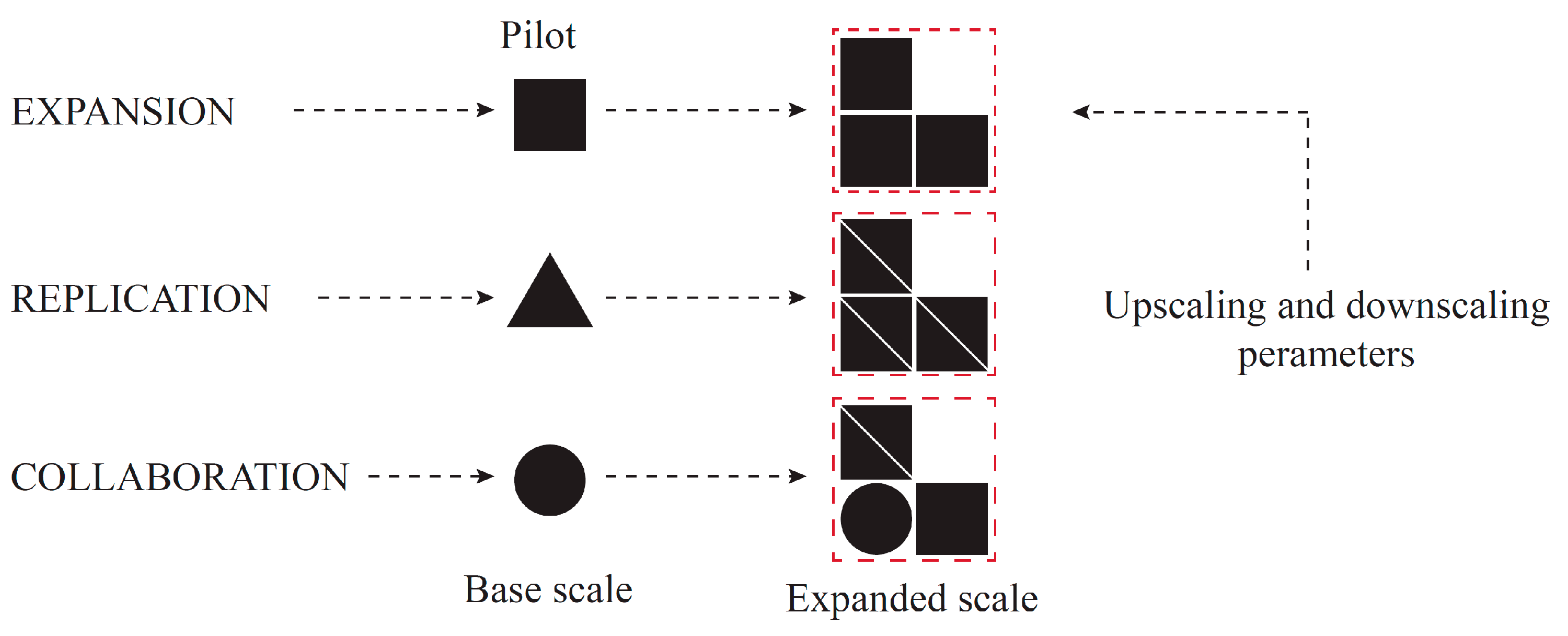
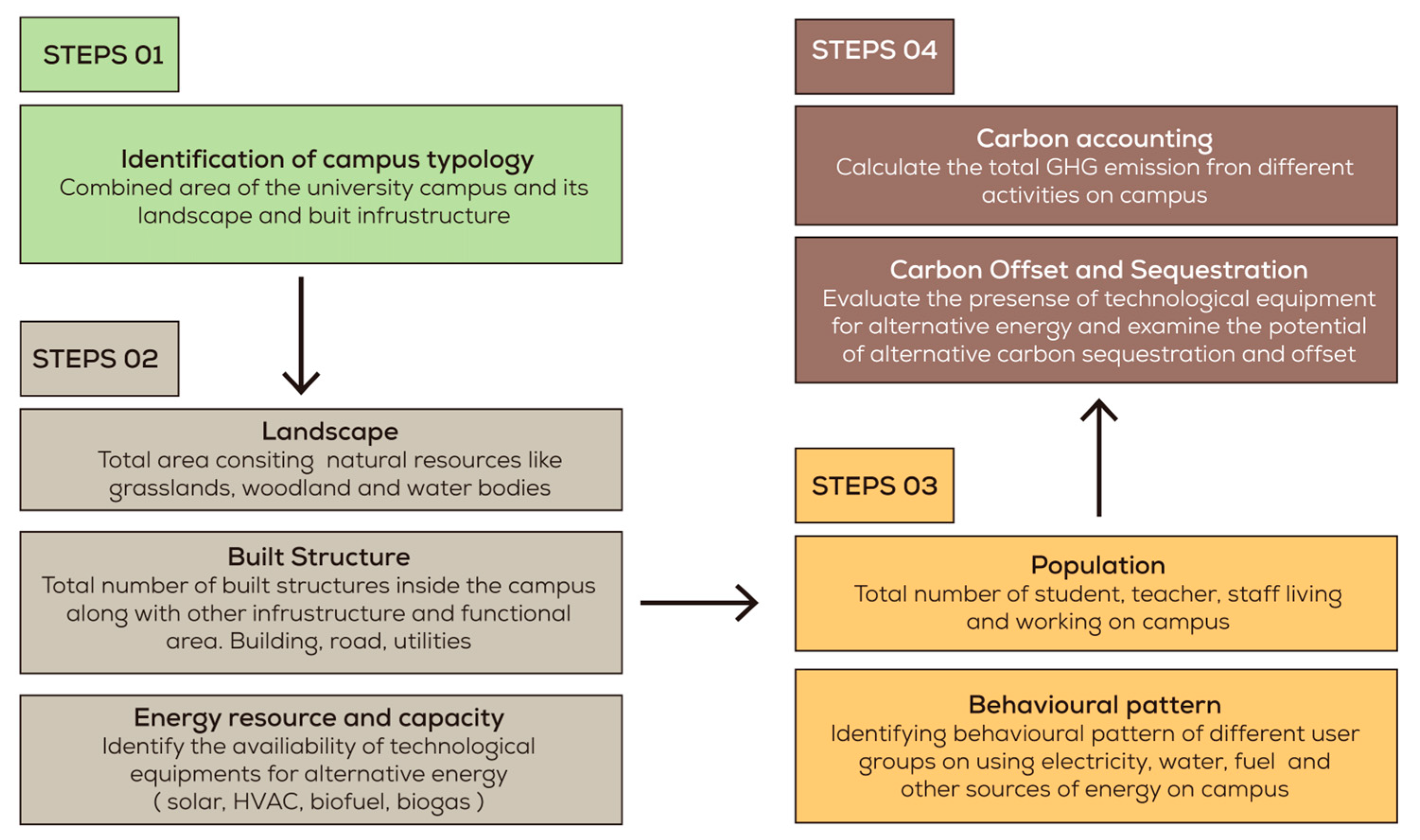
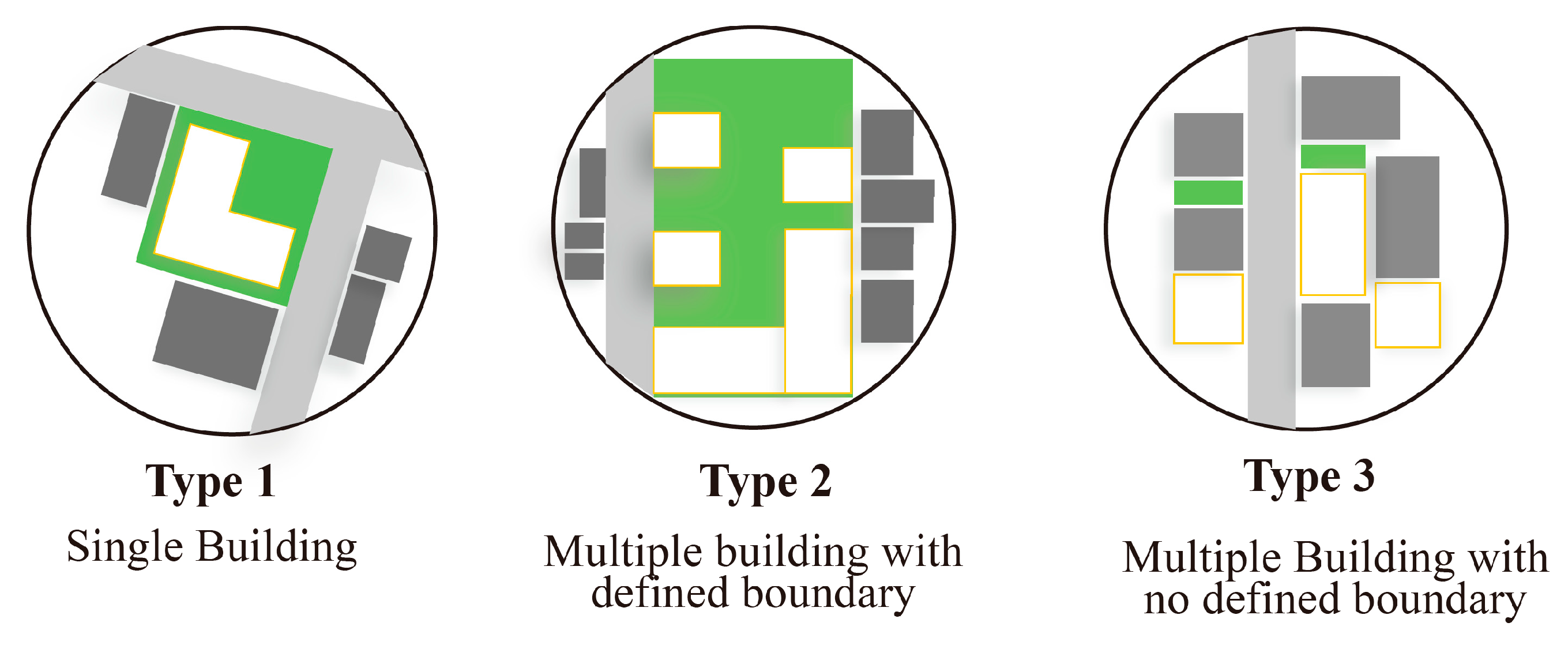


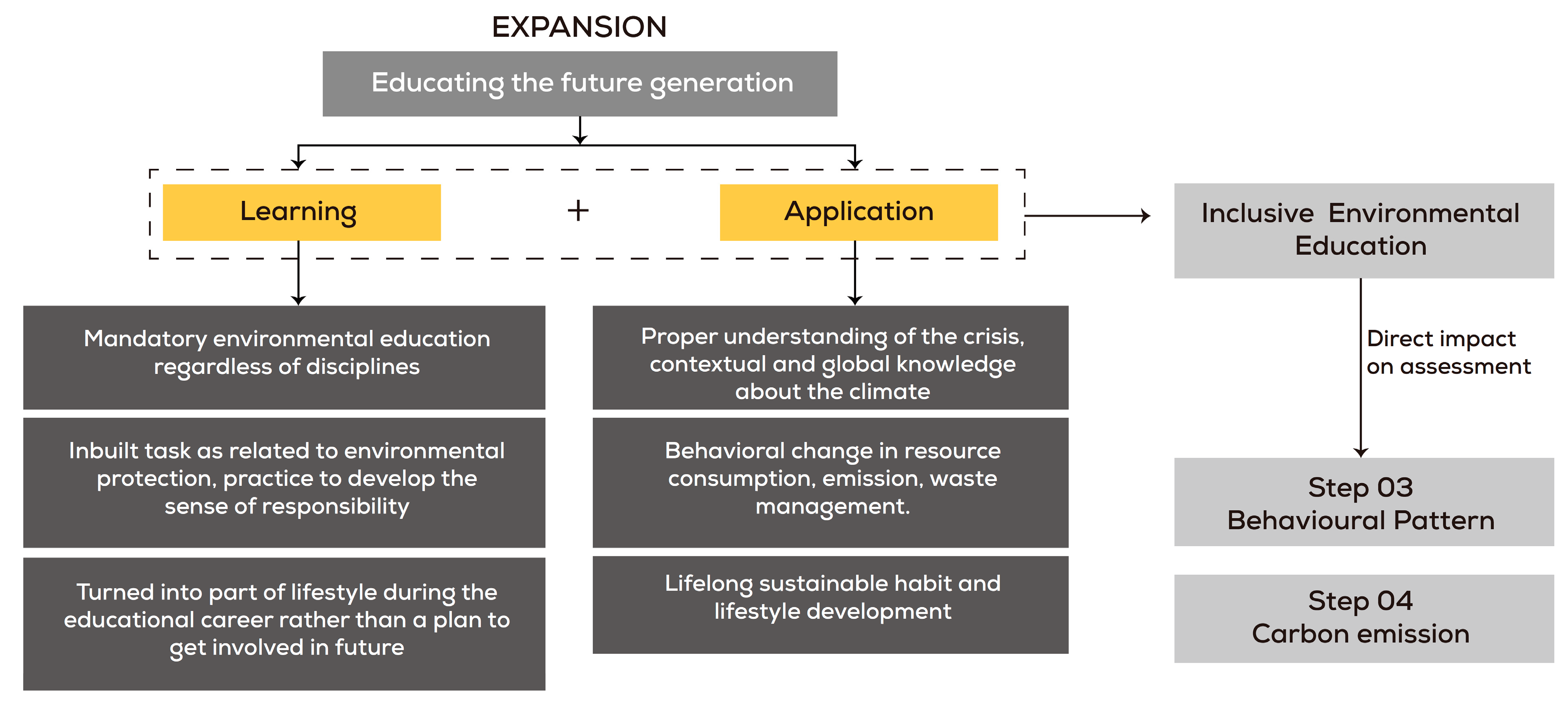
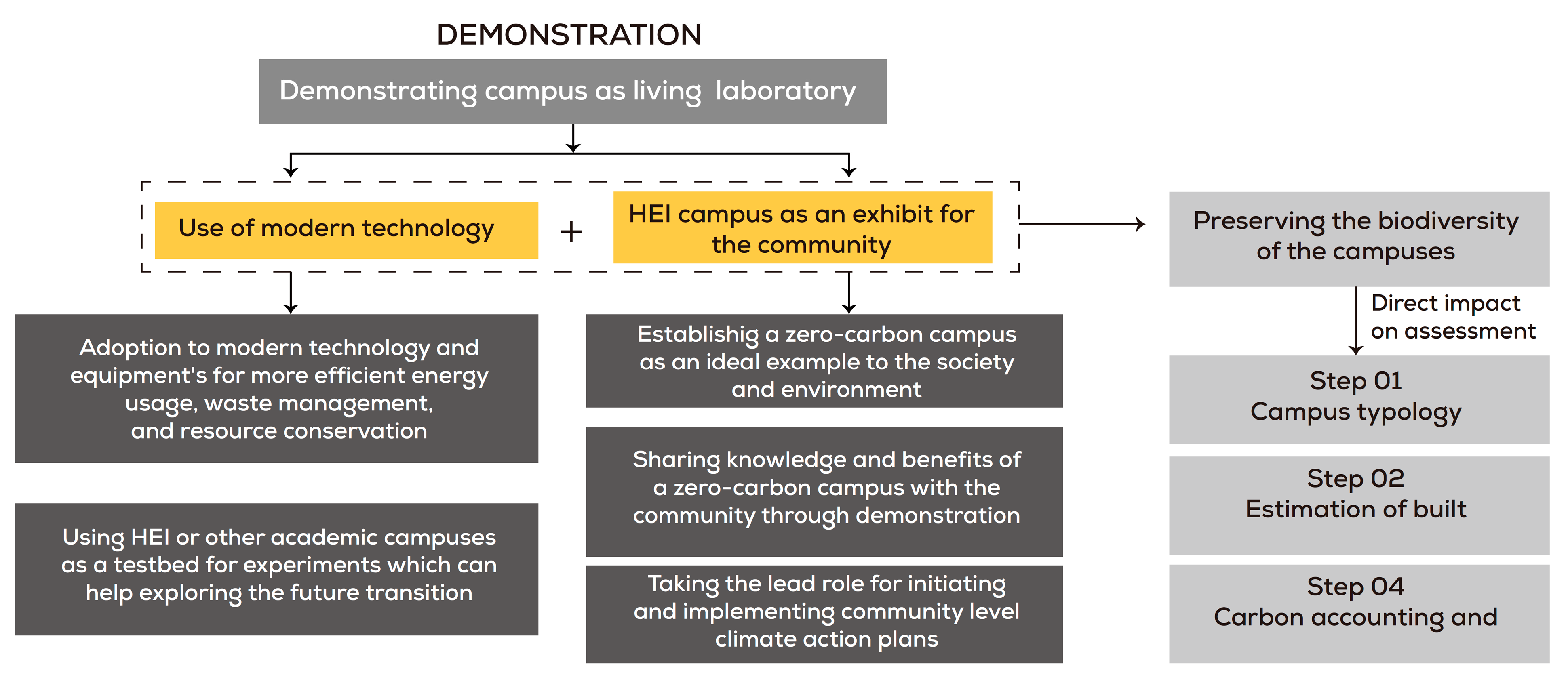
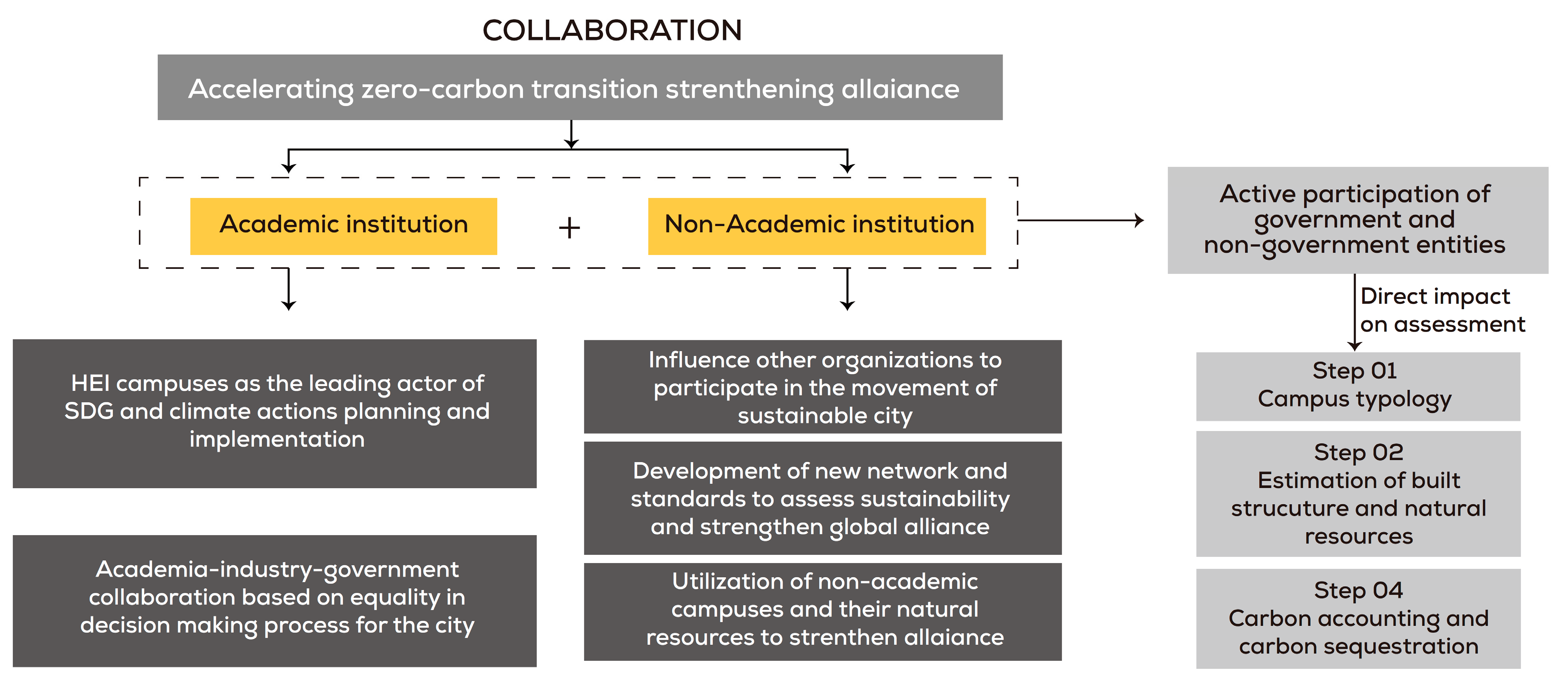
| Year/Place | Organization/Agreement/Conference/Commitment | Mission/Agenda |
|---|---|---|
| 1972, Stockholm | United Nations Conference on the Human Environment |
|
| 1977, Tbilisi | The Tbilisi Declaration |
|
| 1990, France | The Talloires Declaration |
|
| 1992, Rio de Janeiro | UN Conference on the Environment and Development |
|
| 1993, Japan | The Kyoto Protocol Declaration |
|
| 1992, EU | The signing of the COPERNICUS University Charter for Sustainable Development |
|
| 1993, USA | Second Nature |
|
| 1989, Australia | Partnerships for the Sustainable Development of Cities in the APEC Region |
|
| 1988, UN General Assembly | The Intergovernmental Panel on Climate Change (IPCC) |
|
| 1999, Bologna | The Bologna Declaration |
|
| 2002, UN General Assembly | United Nations Decade of Education for Sustainable Development |
|
| 2007, Indonesia | Conference of the Parties (COP 13) |
|
| 2008, UK | The Climate Change Act |
|
| 2012, Rio de Janeiro | Sustainable Development Goals |
|
| 2014, UNESCO | United Nations Decade of Education for Sustainable Development |
|
| 2015, Paris | The Paris Agreement |
|
| 2016, Ecuador | The New Urban Agenda |
|
| 2021, EU | EU Mission: Climate-Neutral and Smart Cities |
|
| 2021, Glasgow | Conference of the Parties (COP 26) |
|
| 2023, Nairobi | UN-Habitat Assembly (UNHA2) |
|
Disclaimer/Publisher’s Note: The statements, opinions and data contained in all publications are solely those of the individual author(s) and contributor(s) and not of MDPI and/or the editor(s). MDPI and/or the editor(s) disclaim responsibility for any injury to people or property resulting from any ideas, methods, instructions or products referred to in the content. |
© 2023 by the authors. Licensee MDPI, Basel, Switzerland. This article is an open access article distributed under the terms and conditions of the Creative Commons Attribution (CC BY) license (https://creativecommons.org/licenses/by/4.0/).
Share and Cite
Islam, M.S.; Liu, G.; Xu, D.; Chen, Y.; Li, H.; Chen, C. University-Campus-Based Zero-Carbon Action Plans for Accelerating the Zero-Carbon City Transition. Sustainability 2023, 15, 13504. https://doi.org/10.3390/su151813504
Islam MS, Liu G, Xu D, Chen Y, Li H, Chen C. University-Campus-Based Zero-Carbon Action Plans for Accelerating the Zero-Carbon City Transition. Sustainability. 2023; 15(18):13504. https://doi.org/10.3390/su151813504
Chicago/Turabian StyleIslam, Md. Salman, Gengyuan Liu, Duo Xu, Yu Chen, Hui Li, and Caocao Chen. 2023. "University-Campus-Based Zero-Carbon Action Plans for Accelerating the Zero-Carbon City Transition" Sustainability 15, no. 18: 13504. https://doi.org/10.3390/su151813504
APA StyleIslam, M. S., Liu, G., Xu, D., Chen, Y., Li, H., & Chen, C. (2023). University-Campus-Based Zero-Carbon Action Plans for Accelerating the Zero-Carbon City Transition. Sustainability, 15(18), 13504. https://doi.org/10.3390/su151813504









